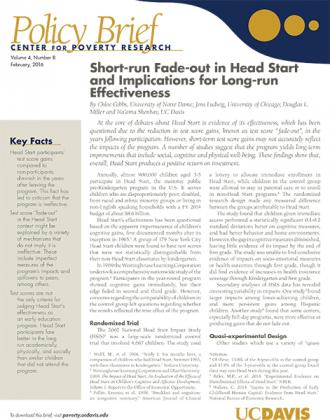Short-run Fade-out in Head Start and Implications for Long-run Effectiveness
By Chloe Gibbs, University of Notre Dame; Jens Ludwig, University of Chicago; Douglas L. Miller and Na’ama Shenhav, UC Davis
At the core of debates about Head Start is evidence of its effectiveness, which has been questioned due to the reduction in test score gains, known as test score “fade-out”, in the years following participation. However, short-term test score gains may not accurately reflect the impacts of the program. A number of studies suggest that the program yields long-term improvements that include social, cognitive and physical well-being. These findings show that, overall, Head Start produces a positive return on investment.
Annually, almost 900,000 children aged 3-5 participate in Head Start, the mainstay public pre-kindergarten program in the U.S. It serves children who are disproportionately poor, disabled, from racial and ethnic minority groups or living in non-English speaking households with a FY 2014 budget of about $8.6 billion.
Key Facts
- Head Start participants’ test score gains compared to non-participants diminish in the years after leaving the program. This fact has led to criticism that the program is ineffective.
- Test score “fade-out” in the Head Start context might be explained by a variety of mechanisms that do not imply it is ineffective. These include imperfect measures of the program’s impacts and spillovers to peers, among others.
- Test scores are not the only criteria for judging Head Start’s effectiveness as an early education program. Head Start participants fare better in the long run academically, physically, and socially than similar children who did not attend the program.
Head Start’s effectiveness has been questioned based on the apparent impermanence of children’s cognitive gains, first documented months after its inception in 1965.[1] A group of 179 New York City Head Start children were found to have test scores that were not statistically distinguishable from their non-Head Start classmates by kindergarten.
In 1969 the Westinghouse Learning Corporation undertook a comprehensive nationwide study of the program.[2] Participants in the year-round program showed cognitive gains immediately, but their edge faded in second and third grade. However, concerns regarding the comparability of children in the control group left questions regarding whether the results reflected the true effect of the program.
Randomized Trial
The 2002 National Head Start Impact Study (HSIS)[3] was a large-scale randomized control trial that involved 4,667 children. The study used a lottery to allocate immediate enrollment in Head Start, while children in the control group were allowed to stay in parental care or to enroll in non-Head Start programs.[4] The randomized research design made any measured difference between the groups attributable to Head Start.
The study found that children given immediate access performed a statistically significant 0.1-0.2 standard deviations better on cognitive measures, and had better behavior and home environments. However, the gap in cognitive measures diminished, leaving little evidence of its impact by the end of first grade. The study was unable to find conclusive evidence of impacts on socio-emotional measures or health outcomes through first grade, though it did find evidence of increases in health insurance coverage through kindergarten and first grade.
Secondary analyses of HSIS data has revealed interesting variability in impacts. One study[5] found larger impacts among lower-achieving children, and more persistent gains among Hispanic children. Another study[6] found that some centers, especially full-day programs, were more effective at producing gains.
Quasi-experimental Design
Other studies which use a variety of “quasi-experimental” research designs[7] find a positive effect of Head Start on long-term economic and physical outcomes. For example, one study based on siblings with different exposure to the program found that Head Start increases the probability of graduating from high school, acquiring some college education and less criminal activity.[8]
A recent study[9] finds that the Head Start intervention also improves health, introducing yet another means by which it leaves a lasting impact. The authors estimated that participation in Head Start reduces the likelihood of being overweight and having a disabling condition during adolescence.
Fade-out and Long-term Effects
Test score fade-out is not necessarily inconsistent with overall gains in other areas such as health and home environments. Research has documented test score fade-out among the same cohorts that later show long-term improvements in other measures,[10] which means that a similar pattern of fade-out and future improvement may also be true for children currently in Head Start.
If fade-out is consistent across groups of children starting the program in different years, it suggests that the long-term improvements identified in research on earlier cohorts of children may not be discounted as being unique to an earlier and more effective version of Head Start.
Other programs also show a similar pattern. Test scores of children who attended Perry Preschool, a well-regarded preschool intervention, also exhibit test score fade-out. Reductions in kindergarten class size have this feature as well. Additionally, a recent study[11] on housing vouchers found substantive long-run gains for young children, despite earlier studies finding no short-run impacts.
Positive spillovers from Head Start children may also reduce the program’s measured effects. If Head Start children are more advanced when they enter kindergarten, schools may divert resources to their less-prepared peers. As those peers catch up, the visible benefits of Head Start would diminish.
What is the right outcome measure?
Test scores may not reflect the main benefits of Head Start participation. Important and lasting improvements in health, behavior and executive control, for example, may not be captured in these scores. This is consistent with studies that find that health gains from Head Start persist from preschool onwards. Documented increases in parental involvement[12] may facilitate these health outcomes as well as other improvements in as yet unmeasured areas.
Chloe Gibbs is an Assistant Professor of Economics at the University of Notre Dame.
Jens Ludwig is a Professor of Public Policy at the University of Chicago Harris School of Public Policy.
Douglas L. Miller is a Professor of Economics at UC Davis.
Na’ama Shenhav is a Ph.D. candidate in Economics at UC Davis.
[1] Wolff, M., et al. 1966. “Study I: Six months later, a comparison of children who had Head Start, Summer 1965, with their classmates in kindergarten.” Yeshiva University.
[2] Westinghouse Learning Corporation and Ohio University. 1969. The Impact of Head Start: An Evaluation of the Effects of Head Start on Children’s Cognitive and Affective Development, Volume 1: Report to the Office of Economic Opportunity.
[3] U.S. Department of Health and Human Services, Administration for Children and Families. 2010. “Head Start Impact Study: Final Report.” Washington, DC.
[4] Of these, 13.8% of the 4-year-olds in the control group and 17.8% of the 3-year-olds in the control group found their way into Head Start during this year.
[5] Bitler, M.P., et al. 2014. “Experimental Evidence on Distributional Effects of Head Start.” National Bureau of Economic Research.
[6] Walters, C. R. 2015. “Inputs in the Production of Early Childhood Human Capital: Evidence from Head Start.” American Economic Journal: Applied Economics.
[7] These use non-experimental variation to replicate experimental conditions. Researchers argue that these estimates of causal effects are highly credible. In practice, credibility varies depending on how close the study conditions are to an experiment.
[8] Garces, E., et al. 2002. “Longer-Term Effects of Head Start.” American Economic Review.
[9] Carneiro, P., et al. 2014. “Long-Term Impacts of Compensatory Preschool on Health and Behavior: Evidence from Head Start.” American Economic Journal: Economic Policy.
[10] Deming, D. 2009. “Early Childhood Interventions and Life-Cycle Skill Development: Evidence from Head Start.” American Economic Journal: Applied Economics.
[11] Chetty, R., et al. 2015. “The Effects of Exposure to Better Neighborhoods on Children: New Evidence from the Moving to Opportunity Experiment.” National Bureau of Economic Research.
[12] Gelber, A., et al. 2013. “Children’s schooling and parents’ behavior: Evidence from the Head Start Impact Study.” Journal of Public Economics.
#povertyresearch












